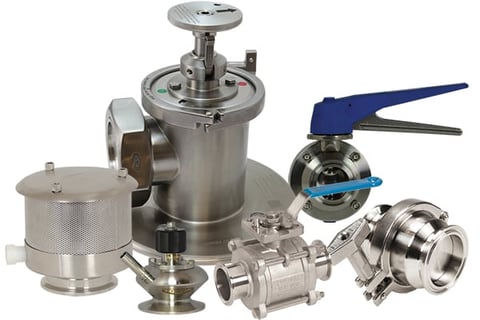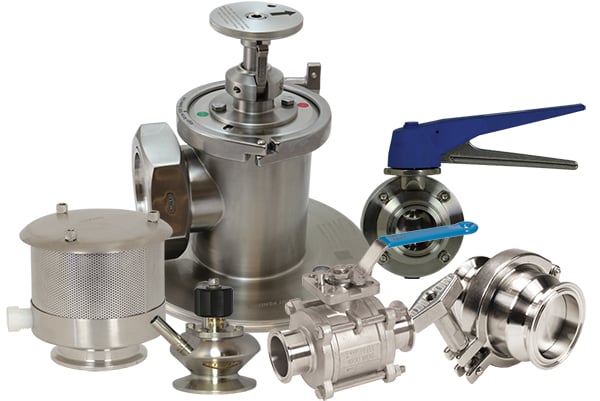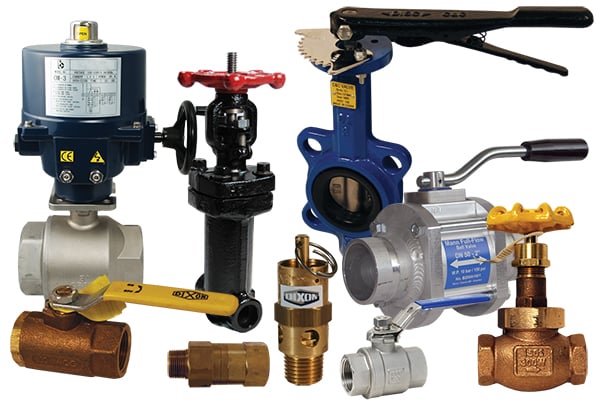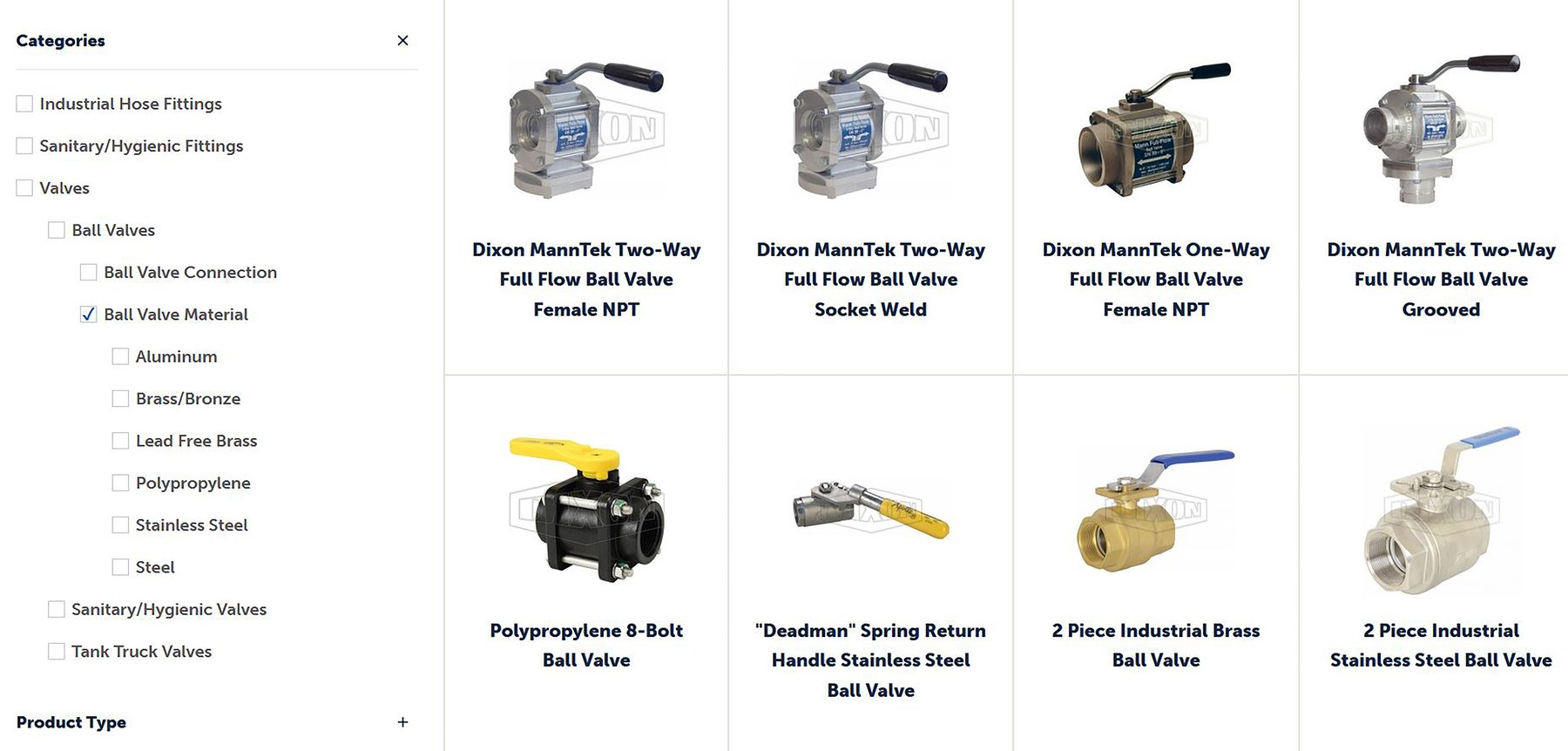
From doing a load of laundry to turning up the heat in your home, everyday life wouldn’t be the same without valves. We can trace the origin of the valve back to the Romans who regulated the flow of water using branches, tree trunks, and stones. They were the first to create anything resembling a formal canal system — and are therefore credited with creating the valve. However, the modern history of valves dates back to 1705 when Thomas Newcomen invented the steam machine. He needed valves to hold back the steam to build up intense pressure in order for the machine to operate. Today, there are a multitude of valves that vary in design and application and are used across a number of industries. One of the most common differentiators between valves is whether they are sanitary or industrial.
So, what’s the difference between sanitary and industrial valves? Keep reading to find out what sets them apart.
What is a Sanitary Valve?

A sanitary valve also referred to as a hygienic valve, is designed and constructed in such a way as to minimize the potential for bacteria to be harbored within the valve that may lead to product contamination. Its design and materials of construction can be easily cleaned, whether manually by hand or while installed in the process line.
What is an Industrial Valve?

We refer to an industrial valve as any valve that is not in compliance with hygienic design principles and materials of construction. Typically, these are valves that are constructed of cast iron, brass, or other materials that are not intended for direct contact with food products. Most often industrial valves use a non-sanitary connection type such as National Pipe Tapered threads (NPT) and do not have a minimum interior surface finish requirement.
What Materials Are Used to Make Sanitary Valves?
For the steel components of the valve, sanitary valves are typically constructed from either 304 or 316-series stainless steel. Depending on the valve application, more exotic grades of stainless steel such as AL6XN can be used for highly corrosive applications like high temperatures, high pressure, and chemicals.
For rubbers and plastics used in sanitary valves, various authorities within the industry set standards that must be met by these materials. Some examples would be FDA 21CFR.177.2600, 3A Sanitary Standard 18-03 Requirements for Rubbers, or US Pharmacopeia (USP) specific requirements. These material standards and specifications are designed to protect the integrity of the product being processed and therefore protect the consumer from contamination. One of the most common plastics used is PTFE, while common rubber types are EPDM, FKM, NBR, and Silicone.
What Materials Are Used to Make Industrial Valves?
Unlike sanitary valves, industrial valves don’t need to meet the same safety standards since they aren’t typically used in the food industry. Choosing proper materials for industrial valves has more to do with keeping the system in proper condition and extending its functional lifespan. Most industrial valves are constructed using stainless steel, brass or bronze, ductile iron, Inconel, and Monel.
To make it easier to find the right valve for your needs, try out our Dixon product search where you can filter your search by material.

What Industries Use Sanitary Valves and How Are They Used?
The sanitary valve is widely used for manufacturing pharmaceuticals, food, and consumer chemicals found in products like laundry detergent and toothpaste. Because these valves are used for products that are edible or that come in direct contact with the human body, the production of some machinery is required to have high hygienic conditions.
Sanitary valves perform typical valve functions that are common in a variety of industries, including
- Isolating or diverting a process fluid (ball valves, butterfly valves, seat valves)
- Relieving pressure within a process line (pressure relief valves)
- Sampling a fluid for quality control (sample valves)
- Protecting a process line against reverse flow (check valves)
What Industries Use Industrial Valves and How Are They Used?
Some examples of industries that use industrial valves include building and construction, oil, gas, water, and waste treatment.
Industrial valves are used to regulate liquids, gases, and slurries. These valves control the flow of liquid or gases by opening, closing, and partially obstructing a passageway or pipe.
What is the Difference Between a Sanitary Valve and an Industrial Valve?
The most notable difference between sanitary and industrial valves is the materials of construction. As mentioned above, product contact components in sanitary valves are typically 304 or 316-series stainless steel as these are non-toxic and resistant to corrosion. Rubbers and plastics must meet industry standard requirements from regulatory bodies such as 3A, FDA, or USP. Additionally, sanitary valves are also designed to be clean-in-place (CIP) or easily disassembled for manual cleaning, often referred to as clean-out-of-place (COP), on a regular basis.
Most industrial valves are not disassembled after installation unless there is a failure requiring maintenance to the valve. Sanitary valves, unlike industrial valves, also must meet strict design criteria for the internal product contact surfaces of the valve; this is essential to food safety.
A Quick Look: Sanitary Valves vs. Industrial Valves
Sanitary Valves
Industries:
- Pharmaceuticals
- Food
- Consumer chemicals
Materials:
- 304 or 316 series stainless steel
- PTFE plastic
- EPDM, FKM, NBR, and Silicone rubber
Industrial Valves
Industries:
- Building and construction
- Oil
- Gas
- Water and waste treatment
Materials:
- Stainless steel
- Brass or bronze
- Ductile iron
- Inconel
- Monel
Do you need help selecting the right valves for your needs? Browse our product catalog or get in touch with a Dixon specialist today!


